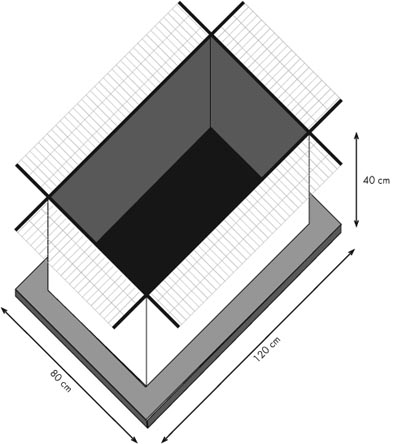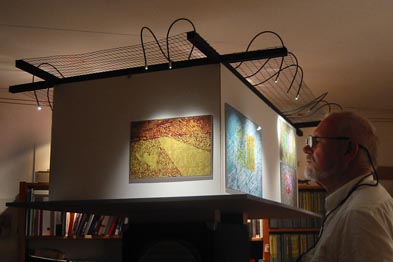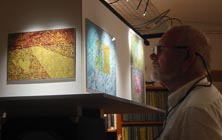Introduction
The media-artist came up with an idea: how to dig into something that is covered or hidden by the process of producing images. He ended up with a proposal for an exhibition to be located in a rather traditional and small exhibition gallery in Copenhagen called Gallery Clausen.
He wanted to play with the scale of the exhibition. He wanted to present around ten large paintings [81 x 122 cm] in a traditional manner and then digitize them and in that process they lose their original size and become objects for re-sizing. He thought that the original size could be liberated and made open for new combinations and new emphases just like it would normally appear in the layout of a magazine.
He ended up with the idea of constructing an exhibition room for the model that turned the inside out. There was literally a white cube in the middle of the model and on this cube the reduced and re-sized photographs of the paintings were curated and placed. From a viewer point-of-view she would only be able to see the pictures hanging on one wall of the model, and she had to move around the model to see the other sides and pictures in the model and to create a narrative.

Drawing of the model seen from abow.
To stress the illusion of looking at a exhibition room in full scale the media-artist used eighteen small fiber optic lamps to lit up the pictures on the wall as the whole installation were placed on a 146 cm high column in a total dark room.

Photo of the artist looking at the small-scale model.
To stress the illusion of looking at an exhibition room in full scale the media-artist used eighteen small fiber optic lamps to light up the pictures on the wall as the whole installation was placed on a 146 cm high column in a totally dark room.
So first of all he painted some acrylic paintings where he was fighting with what he named »The Covered Gaze«. And he gave himself more words to challenge himself, like uncover, excavate, find and cover, forget, repress. This is something that will appear and something that will remain or be elucidated being covered up. The absent is present but the present is also being absent.
The artist paints! Through the actual process of using paint, the traces of the archaeological process are added and covered in a circling around the dialogue with the visual culture.
Traces of comics like ‘Rob the Rover’ and ‘Hopalon Cassidy’ are emerging but these traces are mixed with or appear from geological stone structures, organic wood structures, kitsch from the 1950ies, Portuguese tiles...
These many manifest layers mix in the individual picture and they constitute a coherent narrative in one painting and between the eleven paintings. And then there are the internal relations with the ‘original’ acrylic paintings in their ‘original’ size – and the same images as they are transformed and re-sized in the Model Exhibition.
In a note the media-artist show his interest in the scaling effect: “In the model reproductions of the original paintings are transformed from being representations to becoming presentation.” What he means is maybe that in all sizes and in all materials the images are original and authentic, because what constitutes the original and the authentic is not the production circumstances but the context of presentation as a whole in the Model Exhibition and placed in the physical Gallery Clausen in Copenhagen.
I think that the media artist is fascinated by the shift the visitor has to make, standing in between the big versions of the paintings and the miniature version of the narrative. From this meeting the visitor can fetch from the forgotten what has been repressed, forgotten, buried, amassed.
|

